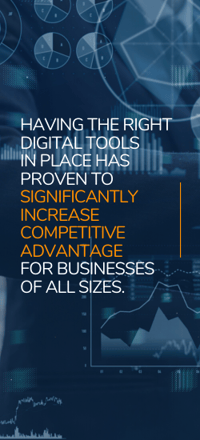The right technology can play a significant role in helping you grow your business, increase revenues and outperform the competition. We explain the details behind this, using a business technology pyramid to outline all the important layers that you should consider.
If you think of business technology as layers on a pyramid - with the basics on the bottom - it follows that the higher you move on the pyramid, the more likely it is that technology will increase your competitive advantage.
That also means that the bottom two layers of the pyramid are table stakes and are the minimum requirements to even be in business. This technology foundation is the absolute critical foundation for everything else.
If you don't get those right you're potentially jeopardizing your business, which is why a lot of companies outsource these foundational services to IT services and support provider.
Moving up the pyramid reaps even more business benefits - think growth and revenue - so read on to learn how to grow your business with technology based on this model.
Let's take a look at each of these layers, starting at the bottom and moving up:
- Layer One: IT Infrastructure
- Layer Two: Security, Compliance and Backup & Disaster Recovery (BDR)
- Layer Three: Productivity and Communications
- Layer Four: Line of Business Applications
- Layer Five: Digital Transformation
.png?width=742&name=Grow%20Your%20Business%20Pyramid(2).png)
Layer One: IT Infrastructure
These are your servers, switches, computers, routers, etc. It’s critical you keep this foundation up-to-date for a bunch of important reasons, starting with budget.
Technology changes fast and you might be surprised to find that you can actually save money by upgrading your technology.
But far more importantly, outdated or poorly maintained hardware and software can cause a host of problems for a business. Not only are your employees likely struggling to use older technology, which means poor productivity, you're opening up yourself to huge risks from a cyber security point of view.
Your goal is to keep your business processes as efficient as possible, which means your underlying IT infrastructure needs to be stable, secure and as up-to-date as possible.
Typically this requires some level of IT automation, and if you can't manage this in-house, consider outsourcing this task to qualified Managed IT Service Provider.
Which leads us to the next layer.
Layer Two: Cybersecurity, Compliance and Backup & Disaster Recovery (BDR)
You might be surprised by how many businesses don't address these three areas properly. We see it all the time, and try our best to make proactive and strategic recommendations to keep our clients data safe from modern hackers.
Let's start with cybersecurity.
Despite repeated headlines of companies brought to their knees due to cyber attacks and data breaches, dire warnings on the dangers of ransomware and phishing, and a constant stream of articles such as how to prevent cyber attacks in your social feeds - most business are WAY behind on security prevention.
Your customers expect you to keep their digital data secure. They expect your systems to be up and running even in the face of disaster, and quickly recoverable should an event occur. And I'm sure you don't even want to think about dollars lost in downtime after an attack if you don't recover quickly!
And yet we still see alarming statistics such as 73% of companies are NOT prepared for hackers and that 60% of small businesses go out of business after a cyber attack.
Still need more incentives to make sure your company is adequately protected?
Just talk to anyone that has attempted to make a claim on cyber insurance - if you don't have the right level of security protection implemented in the first place, don't be surprised when your claim is rejected.
Moving on to regulatory compliance.
If you're in a highly regulated industry such as healthcare, financial services, legal services or if you're a government contractor, you're not only expected to maintain compliancy, you're mandated by law.
There are many examples of regulatory compliance laws including GDPR, CCPA, PCI DSS, FINRA, HIPPAA, NIST, DFARS, and many more. Customer data protection is big deal and the number of rules and regulations is only increasing.
Even if you're not regulated by law, you'll find many organizations adhering to these standards as guidelines.
As an example, we have a lot of nonprofit clients who deal with highly sensitive data on high profile donors and constituents - which means a data breach could have disastrous consequences.
Many of them have opted in to the highest level of managed security services possible, mandates or no mandates.
Finally, Back Up and Disaster Recovery (BDR).
Almost every business has some kind of backup in place. The question is, do you have the right data backup and recovery solution in place?
It pays to check this out BEFORE you need to use it!
Another important point here is that there is a big difference between backup and recovery and true business continuity.
In a nutshell, business continuity is the ability of a business to continue its essential functions in the face of a disaster.
This is different from disaster recovery, which is a solution for restoring interrupted services after a disruption.
Most companies will want to have a documented Business Continuity Plan to ensure that as little time as possible is lost, and that business can continue as smoothly as possible, should a disaster occur.
Layer Three: Business Productivity and Communications
If you’re using Microsoft Office 365, G-Suite or something similar, you’re using business productivity technology.
Of course, there's a huge long list of business productivity software on the market today, from team collaboration to email management to time management, scheduling tools, customer support tools and more.
You certainly don't need every last new piece of software that comes along, but there is a strong argument for making sure you're up-to-date on productivity applications.
Not only is old software and hardware more costly to maintain, you can be sure it's slowing down efficiency throughout your organization.
Communications has also changed drastically over the past decade. New cloud-based technologies have ousted older, premise-based telephony solutions, mostly due to cost but also access to features that you just can't get with older systems.
If you're dealing with an aging business phone system, take a look at the new Unified Communications and Collaboration options, which offer not just voice but instant messaging, video chat, desktop sharing, mobility features and much more.
The bottom line is that outdated IT systems can really hold you back, especially in the face of relentless competition - there's always someone at the ready to do things better and faster than you!
Layer Four: Line of Business (LOB) Applications
Many businesses own applications that are designed to support specific industry needs.
Sometimes these are well-known, commercially available applications and services that have been specifically designed for, as example, the nonprofit world, architecture and design firms, manufacturing, banking, legal, healthcare and others.
Other times an organization will decide to pay to have a custom solution developed. This can be the pinnacle of a competitive advantage, or just the opposite.
- If you’re taking full advantage of custom-built LOB software, you might be head and shoulders above the competition
- Conversely, if you’re paying for ongoing development and maintenance of outdated software that someone in the organization built a long time ago, you could be throwing valuable dollars away
Are you paying for complex software that you’re not really taking advantage of?
Are you stuck with legacy business software that is expensive to maintain, when there are more up-to-date tools that could be used instead?
These are questions that should be investigated, and you might find it worthwhile to get a qualified IT consultant to do an assessment of your existing technology stack.
Layer Five: Digital Transformation and Tools
There's been a lot of fancy stuff written about digital transformation, but really it's just a term for the shift we're experiencing as a society.

As the world becomes increasingly digital, so is the way businesses work. It's not changing what businesses do - it's just changing which platforms and tools businesses use which ultimately changes their processes and workflows.
There's no question that having the right digital tools in place has proven to significantly increase competitive advantage for businesses of all sizes.
Used to be that only the big guys had access to sophisticated digital tools, but thanks to the cloud and other advancements, most of these tools are well within the reach of almost any business.
As a proof point, in a recent small business study commissioned by Google, results showed that “digitally engaged” small businesses (defined as under 250 employees) were able to generate significantly more revenue per employee.
In the survey, four key categories of digital engagement emerged, along with percentages of businesses that were taking advantage of them. Keep in mind this was a 2017 study so these stats may have changed a little bit, but still these are interesting results which show a pattern.
- 20% had an undeveloped digital presence, relying on basic tools such as email, but with no significant website or social media presence.
- 30% took advantage of basic digital tools, such as a simple website and email marketing, but had limited social media presence and no e-commerce capabilities.
- 30% had a more advanced website with mobile or e-commerce capabilities, and engaged with multiple social media and online marketing channels. They also tended to use digital tools internally such as collaboration and other cloud software.
- 20% utilized more sophisticated digital tools such as web analytics to analyze customer trends, mobile apps for customer engagement, and sophisticated online marketing tools such as SEO and video advertising.
Overall, the survey results showed that for each additional engagement level reached, businesses experienced an increase of revenue growth of 11 percentage points.
Clearly it pays to invest in today’s digital tools!
Summary: How To Grow Your Business With Technology
We started off this article by stressing the importance of Layer One and Layer Two.
But if most of your resources are spent in maintaining these table stakes layers, which is often the case especially for small IT teams, you're missing out on the competitive advantages of the upper layers of the pyramid.
This is a primary reason why many businesses outsource some or all of these layers to a Managed IT Services Provider who can ensure that as a minimum, the foundation is taken care of.
This allows internal IT staff to concentrate on more strategic initiatives, leaving the routine tasks to a third party. This arrangement is often referred to as co-managed or supplemental IT.
If you're interested in learning more about the trend to supplemental IT, read our solution guide which tells the stories of 8 different IT execs from real companies, and why they chose to outsource specific IT functions.
(Click below to download immediately - no email required!)





